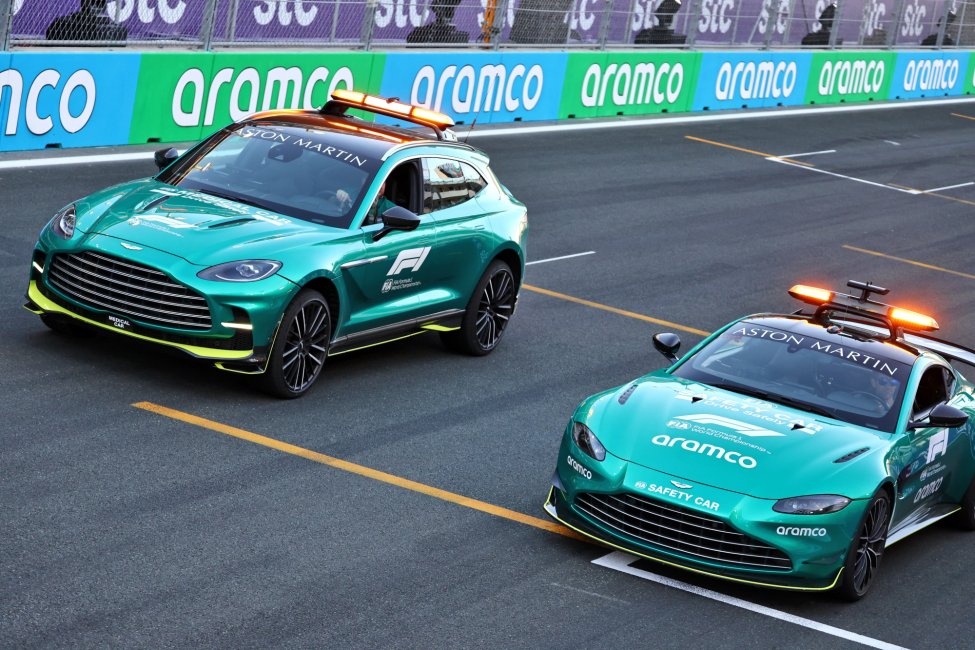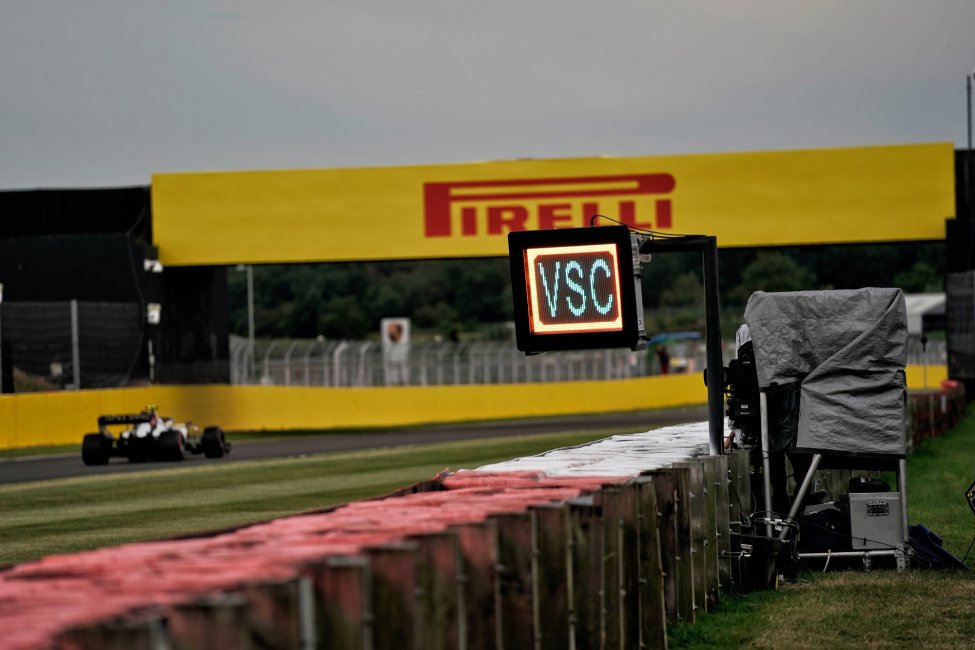Safety Car F1
The safety car plays an important role in Formula 1 safety. What is a safety car, what does it do and why is a safety car not a Formula 1 car? Read all about it on this page!

What is a safety car?
A safety car in Formula 1 is a car that enters the track when a dangerous situation has arisen on the track. This could be a crash, for example, or very bad weather conditions. When the safety car enters the track, Formula 1 drivers are informed by marshals who display signs with 'SC' on them and yellow flags are waved. Drivers are also notified on the screen on the steering wheel.
All Formula 1 drivers must continue to drive behind the safety car, provided there is an indication that those behind are allowed to overtake the safety car. During a safety car period, drivers are not allowed to overtake each other. The safety car remains on the track until the dangerous situation is resolved and the track is safe to race again.
History of the safety car in Formula 1
During the 1973 Canadian Grand Prix, the safety car, also known as the pace car, was used for the first time, namely a yellow Porsche 914. This safety car only entered the track incorrectly, putting a driver a lap behind. After the race, it took several hours before the official results were known.
In the 1990s, the safety car was officially written into the regulations after a number of serious accidents occurred. The safety car has since become an indispensable part of Formula 1, ensuring the safety of F1 drivers on the track.
Who is driving the safety car?
The safety car is driven by a professional driver appointed by the FIA. Since the year 2000, German Bernd Mayländer has been the one driving the safety car. Like Formula 1 drivers, Maylander also practices with the safety car. This ensures that he knows the car well. A co-driver also sits next to Maylander. Among other things, the co-driver deals with communication with race control, the position of the safety car on the track and keeps a close eye on unsafe situations (such as oil on the track).
What if Maylander is unable to drive the safety car because he is ill, for example? Then he will be replaced by the driver of the medical car, namely Alan van de Merwe. The medical car can then be driven again by a reserve Formula 1 driver present during a Grand Prix.
What if the safety car suffers mechanical failure? That's no problem either, there are always two exactly the same safety cars present and equipped with exactly the same equipment.
Slower pace safety car
During a safety car period, you sometimes hear Formula 1 drivers saying on the board radio that the safety car is driving too slowly. Maylander explains that the slower pace is really necessary to keep the situation safe and that it would be weird if he drove on the limit all the time. There has to be a safety margin. And 'slow' is of course a relative term. The safety car can easily hit speeds above 300 km/h.
Aston Martin and Mercedes safety car
Since the 2021 season, Aston Martin has been the supplier of the safety and medical car in Formula 1. The Aston Martin Vantage safety car does still alternate with the Mercedes-Benz AMG GT R.
Why is a safety car not a Formula 1 car?
There are a number of practical reasons why a safety car is not a Formula 1 car. Among other things, there are many useful options in a safety car and space is needed for two people (the safety car driver and co-driver). This is difficult to make it all fit in a Formula 1 car. Cost also plays a big role. All the information on why a safety car is not a Formula 1 car can be found in the video in this article.
Virtual Safety Car (VSC)
In addition to the 'physical' safety car that drives on the track during an unsafe situation, the virtual safety car (VSC) has been around since 2015. The first virtual safety car was deployed during the Monaco GP (2015). This happened after Romain Grosjean and Max Verstappen crashed. What is a virtual safety car in Formula 1? During a VSC situation, no safety car enters the track, but drivers receive a notification on their steering wheel and must adjust their speed to a set minimum.
The virtual safety car allows the race to resume faster and there are fewer interruptions. For example, during a VSC situation, marshals may come onto the track to remove dangerous objects. When the virtual safety car ends, drivers will again receive a notification on their screen on their handlebars that they can resume racing at full speed.
Pit stop during the safety car
When a Formula 1 driver makes a pit stop during the period of a (virtual) safety car, he/she loses a lot less time compared to a pit stop during the normal course of a race. This is because the cars on the track are moving a lot slower, so less time is lost. For example, if the total time (including entry and exit) during a pit stop is 22 seconds during a normal situation, it can be only 11 seconds during a safety car situation.
Crashes behind the safety car
The main task of the safety car is obviously to ensure the safety of Formula 1 drivers, yet some unexpected things, such as crashes, happen during a safety car period.
Some examples include:
Michael Schumacher and Juan Pablo Montoya
For example, Michael Schumacher and Juan Pablo Montoya crashed during the 2004 Monaco Grand Prix. Schumacher wanted to warm up his tyres behind the safety car, but that didn't go quite right. You can see how that went in the video in this article.
Romain Grosjean in Baku
Another crash in the collective memory behind a safety car is that of Romain Grosjean at the 2018 Azerbaijan Grand Prix. He drove into the wall and shouted 'I think Ericsson hit us' over the board radio. However, Ericsson was nowhere near him and Grosjean caused his crash all by himself.
George Russell at Imola
George Russell is no stranger to crashing behind the safety car either. In the 2020 season, he drove his Williams behind the safety car at the Imola Grand Prix. Unfortunately, he lost control and ended up in the wall.
Safety car drives over Taki Inoue
Another bizarre moment in Formula 1 history involving the safety car is the one involving Japanese driver Taki Inoue. He was run over by the safety car that had overlooked him during free practice in Monaco. Fortunately, this left him with 'only' a concussion.
What are the rules regarding the safety car?
- During a safety car situation, drivers are not allowed to overtake each other and the safety car. However, race control may indicate that the cars that are lapped may pass the safety car in order to rejoin the rear of the field. The lights on the safety car will then turn green. When the lights on the safety car are yellow, the safety car may not be passed;
- During a safety car period, drivers can enter the pit lane at any time, but when exiting they must wait until the pit exit light is green. This should ensure that the driver can join safely behind the safety car and does not have to overtake the distance at full speed;
- After the 2023 Australian GP, it is stipulated that the safety car will exit the pit lane one minute early before the first Formula 1 car follows. This allows drivers to better set their own pace and warm up the tyres;
- During a safety car period, the clock simply keeps running and the laps driven count down;
- During a virtual safety car situation, drivers must adjust their speed to a set minimum;
- When the safety car ends and it is about to leave the track, the lights on the safety car go out. This indicates that the car will enter the pit lane at the end of that lap;
- When a safety car ends, the race leader decides when to step on the gas and the race resumes;
- After the safety car has ended, no DRS may be used for two laps. DRS may not be used at all during a safety car period. This also applies during a virtual safety car period;
- In principle, the race direction does everything possible to prevent this, but a race may end behind the safety car. This happened, for example, during the 2021 Spa Grand Prix, which both started and ended behind a safety car due to heavy rain. The 2022 Monza Grand Prix also ended behind the safety car because of Ricciardo's stranding on lap 48/53.
Don't miss out on any of the Formula 1 action thanks to this handy 2026 F1 calendar that can be easily loaded into your smartphone or PC.
Download the calender



